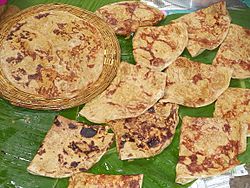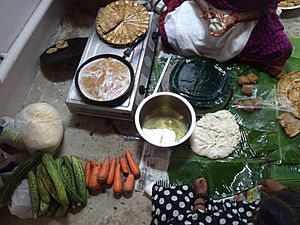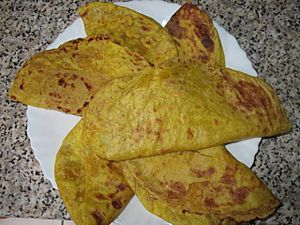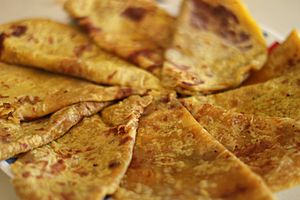Puran poli facts for kids
 |
|
| Alternative names | Bobbattu, obbattu, holige, ubbatti, vedmi, poli, puranachi poli, god poli, pappu bakshalu, bakshalu, oliga, abatulu. |
|---|---|
| Place of origin | India |
| Region or state | Maharashtra, Andhra Pradesh, Karnataka, Gujarat, Goa, Telangana, Kerala and Tamil Nadu |
| Serving temperature | Hot or Cold |
| Main ingredients | Wheat flour, sugar, chana, ghee, jaggery |
Puran Poli is a yummy, sweet flatbread from India. It's a popular dessert or snack, especially in Southern India. People enjoy it during festivals and special meals. This sweet treat is known by many different names across India, like Holige, Obbattu, and Bobbattlu.
Contents
What's in a Name?
This sweet flatbread has lots of names depending on where you are in India!
- In Gujarat, it's called puran puri or vedmi.
- In Telugu-speaking areas like Andhra Pradesh and Telangana, you might hear bobbattlu, baksham, oliga, bhakshalu, pole, or polae.
- In Karnataka, it's often called holige or obbattu.
- In Maharashtra, it's known as puran poli (पुरणपोळी).
- In Malayalam, it's payasabolli or just bolli.
- In Tamil, it's poli or uppittu.
- In Konkani, it's ubbatti or poli.
In Kerala and Tamil Nadu, people often eat it with a sweet rice pudding called paal payasam during big meals and celebrations.
A Sweet History
Puran Poli is not a new invention! Its recipe is very old.
- A book from the 1300s, called Manucharitra, talks about a similar sweet called bakshyam. This book was written in Telugu.
- Even older writings from the 1100s, by a king named Someshvar, also mention this sweet.
- Some ancient health texts, like Bhavaprakash, also describe how to make it.
What's Inside?
Puran Poli is made with simple, tasty ingredients.
- The main ingredients are a type of chickpea called senaga pappu, plain wheat flour, and a sweetener like jaggery (a type of unrefined sugar) or regular sugar.
- For flavor, people often add cardamom powder or nutmeg powder.
- A little ghee (clarified butter) and water are also used.
- Sometimes, other beans like pigeon pea or mung bean are used instead of chickpeas.
- You might also find nuts, dates, or a pinch of turmeric powder for color.
Why It's Good for You
Puran Poli isn't just delicious; it has some good stuff in it too!
- Chickpeas (Chana): These are full of fiber, which helps your digestion. They are also a great source of protein, which helps your body grow strong. Chickpeas also have important minerals like zinc, folate, and calcium.
- Flour, Jaggery, and Sugar: These ingredients give you carbohydrates, which are your body's main source of energy. They help you run, play, and learn!
Different Ways to Make It
The way Puran Poli is made can change a lot from one place to another.
- Flavors: You can find varieties with peanut, coconut, sesame, or groundnut flavors. In some areas, grated coconut is added.
- Sweeteners: People might use Coconut palm jaggery, or a mix of sugar and jaggery.
- Spices: Along the coast, nutmeg is popular, but elsewhere, cardamom is often used, or sometimes both.
- Rolling the Dough: Some people use rice flour to help roll the dough very thin. Others use oil or ghee instead of flour.
- Cooking: It can be cooked on a hot griddle with or without ghee. Sometimes, a little turmeric is added to the dough to give it a lovely yellow color.
The size and thickness also vary. In Gujarat, it's smaller and thicker, while coconut-filled ones might be larger and thinner.
Andhra Pradesh
In Andhra Pradesh, it's usually called bobbattu. It's a must-have sweet for big festivals and special events. People serve it hot with a layer of ghee on top. There's even a version called Rava bobbattu. In some parts, it's called poli or obbattu.
Karnataka
Puran Poli, or holige, is a very special dish in Karnataka. It's served on all important days, especially during the Ugadi festival. The most common type is made with yellow gram (a type of lentil) and sugar or jaggery. You can also find obbattu made with coconut and sugar.
Maharashtra
In Maharashtra, Puran Poli is a traditional dish made for every celebration, especially during Ganesh Chaturthi and Holi. People eat it with different side dishes like Basundi (a sweet milk dish), Aamras (mango pulp), or a sour curry called Kadhi or Amti. In Pune, a special sour curry called Katachi Amti is made using the water left over from cooking the chickpeas for the Puran Poli.
Tamil Nadu and Kerala
In Tamil Nadu, it's called Opputtu, and in Kerala, it's payasaboli. This golden-yellow sweet pancake is often eaten during a traditional meal called Sadhya along with Payasam (sweet pudding).
- You can find different kinds of opputtu, like thenga (coconut) boli and sharkara (brown sugar) boli.
- It's very popular in the southern parts of Tamil Nadu and Kerala.
- People usually enjoy Opputtu after lunch or as an evening snack.
- It looks a bit like a flattened chapati (Indian flatbread).
- "Kadambur opputtu" comes in coconut and brown sugar flavors.
- "Trivandrum Boli" is another type from Kerala.




